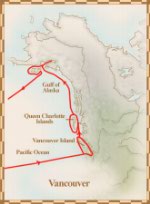 |
|||||||||||||||||||||||
|
|
George Vancouver: A Coast for the English KingExploring the West Coast
|
||||||||||||||||||||||
 |
| Vancouver and his expedition members mapped the west coast of North America from what is now northern Mexico to present-day British Columbia Copyright/Source |
In two seasons, the expedition mapped the coast from what is now northern Mexico to present-day British Columbia. It proved that the Juan de Fuca Strait was not the entrance to a great inland sea. The findings also proved that what is now called Vancouver Island was an island and not part of the mainland. They returned to England in October 1795, after four-and-a-half years of travel and only six men lost.
 | ||
|
During this voyage, Vancouver anchored in Restoration Bay to brew spruce beer. The drink prevented scurvy. Fisher, Robin. Vancouver's Voyage: Charting the Northwest Coast, 1791-1795. Vancouver: Douglas & McIntyre, ©1992, p. 60. |
||
 | ||
|
On one occasion, Vancouver's crew roasted and ate mussels for breakfast that they had gathered on the shore. Feeling terribly sick, they tried to sweat the poison out by rowing hard. By lunchtime one man had died. By drinking large amounts of warm water, the rest of the men vomited and were saved. It was probably paralytic shellfish poison, a toxic organism. |
||
Scene of the Crime
During this voyage, Vancouver returned to the place Captain Cook had been killed 13 years before. The islanders were friendly and traded hogs, vegetables and watermelons (grown from seeds left by a European). Vancouver encouraged the islanders to govern themselves and to use better growing methods for food. The museum at Honolulu, Hawaii has a portrait of Vancouver with this label: "George Vancouver: English navigator and a true friend to Hawaiians."
Gifford, Alison. Captain Vancouver: A Portrait of His Life. King's Lyn, Norfolk: St. James Press, 1986, p. 37.
|
| ||
|
On June 13, 1792, Vancouver sailed into an inlet that was named Burrard's Canal, after Sir Henry Burrard of the Royal Navy. Today, this inlet is part of the city of Vancouver (Canada's third largest city). The original settlement, called Granville, burned down in 1886. A new town was built and renamed Vancouver. Gifford, Alison. Captain Vancouver: A Portrait of His Life. King's Lyn, Norfolk: St. James Press, 1986, p. 41. |
||
 
|